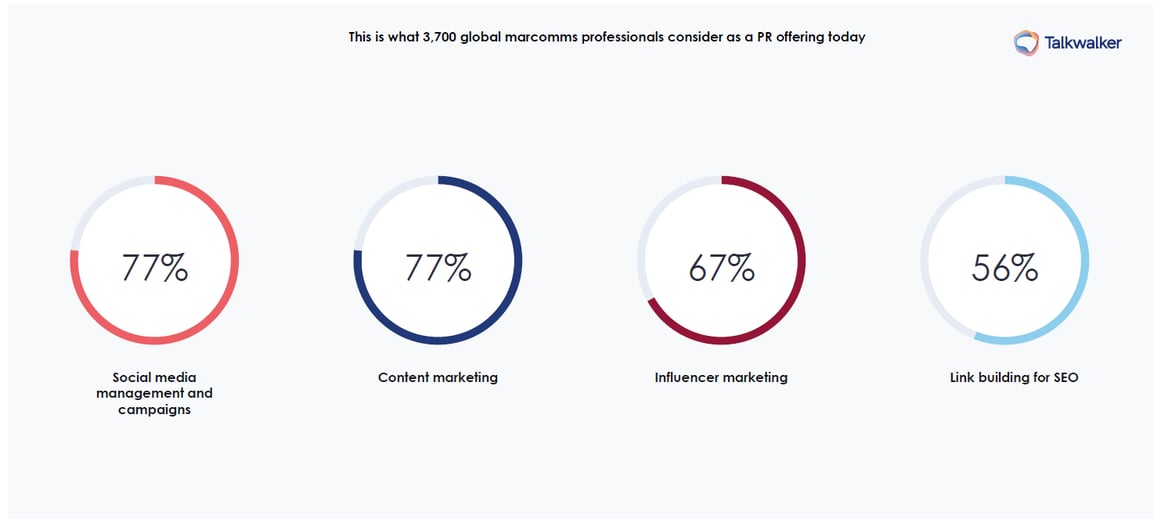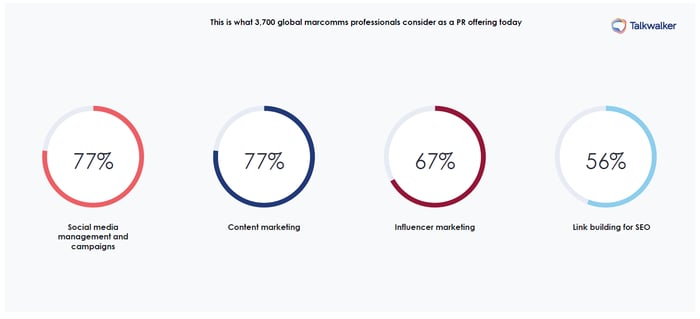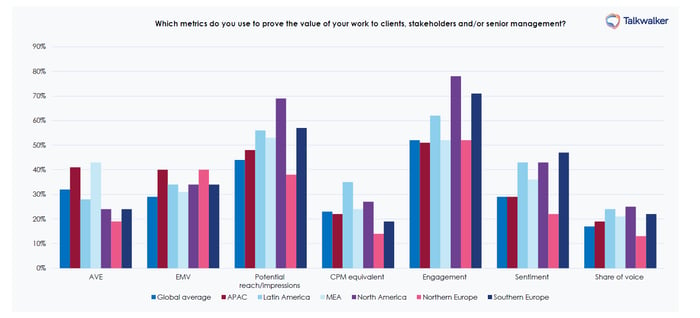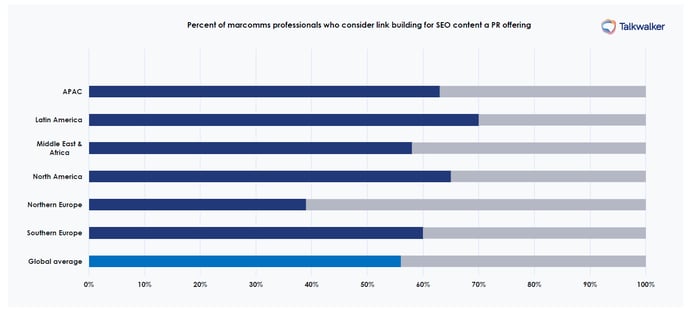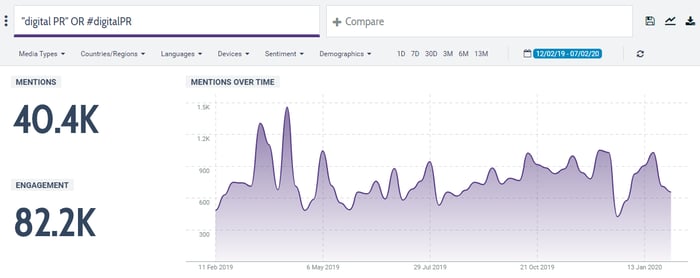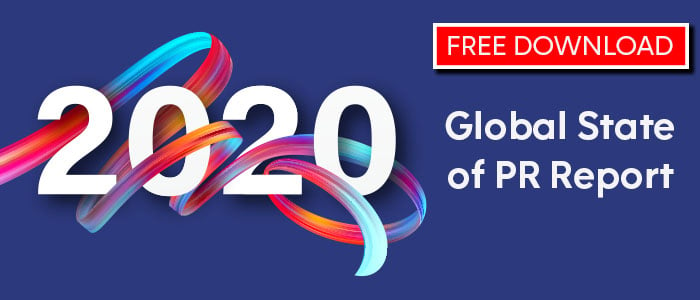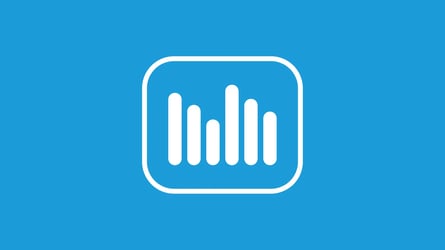Full report: traditional vs digital PR
With the lines between digital, social, SEO, and PR becoming increasingly blurred, we set out to discover how the marcomms industry defines PR today. Together with YouGov, we surveyed 3,700 respondents from across the world to produce a detailed analysis of the opportunities, challenges, and changes the sector is facing.
Get your free copy of the report
Breaking down digital PR
In this blog post, I’ll break down the answers to these commonly asked questions about the world of digital PR:
- Does PR fall under marketing, social or digital?
- How do PR and SEO work together?
- What are the best digital PR metrics?
- What are the top tips for improving digital PR performance?
- Where can I find digital PR inspiration?
Does PR fall under marketing, social or digital?
2020 Global State of PR report reveals the various elements that are considered a PR offering today
PR, content marketing, social media, digital, and SEO are more intertwined than ever before.
Traditionally, PR professionals were mainly focused on positioning and managing a brand’s image through press offices and media interviews.
Today, digital PR marries the qualitative aspect of building and promoting a brand with the more quantitative elements from digital and SEO to inform the PR strategies and tactics.
Both types of PR professionals seek a newsworthy hook that can help them promote their brand. Digital PR professionals always seek to back it up with data assets that can help them build links (more on that below!)
Download the 2020 Global State of PR report
How do PR and SEO work together?
In order for SEOs to do their job, they need to understand their audience and have a solid content strategy in place. These are two tasks that work hand-in-hand with what PR professionals do.
It’s very common practice for PR professionals to deep dive into understanding their target audience and identify key content pillars that speak to their target personas when putting together a PR strategy.
Today, digital PRs who have a good grasp of SEO and work closely with SEO experts are able to inform these PR strategies with data and together achieve organic search success.
Building authority is also another sweet spot where the worlds of PR and SEO meet. A traditional PR professional would focus on positioning brands and increasing awareness through news coverage - using metrics such as AVE or EMV.
Global State of PR report reveals vanity metrics such as AVE & EMV still used to prove value of PR work to stakeholders
Digital PRs, however, are more focused on building links through online coverage about their brands - working with SEOs to measure the value of these links and track their effects on the brands’ website ranking, traffic and conversion to sales.
SEOs, in turn, benefit from the work of digital PRs as web pages with higher backlinks tend to rank higher on SERPs.
There are 3 main types of links:
1) Links from digital PR campaigns
The core skill set here is being able to identify newsworthy content and build a PR strategy around it. The PR strategy is often informed by SEO data such as audience research and keywords - helping brands gain authority by ranking for relevant keywords for their target audience.
Links from news sites also alert Google that your brand is trustworthy - helping it rank further.
This tactic is proven to deliver competitive advantage for clients by adding direct value, increasing brand awareness, referral traffic to the brand’s website, and engaging the target audience.
Here, we see a similar skill set to traditional PR when it comes to knowing the media and being able to pitch to them.
2020 Global State of PR report reveals the Americas and APAC at the helm of regions who consider SEO content a PR offering
Digital PR is also closely intertwined with digital and content marketing. PR professionals can use sponsored content or guest blogs/contributions to tell their brand stories while gaining the external linking domain - although this is not always seen as a best practice from an efficiency point of view.
Download the full PR report for best practices
2) Reclaiming links
Reclaiming links is also a popular way for digital PR professionals to gain link equity. Alerting tools help you stay on top of brand mentions - allowing you to get in touch with news sites or bloggers carrying unlinked mentions of your brand and asking them to link back to your brand’s landing page.
These can be unprompted brand mentions or a result of a digital PR campaign or press release.
You can also use alerts or social listening tools to monitor online mentions of topics related to your brand - and then get in touch with newsite/blog, asking them to link to relevant, existing pages on your brand site (to increase traffic and authority).
There are dedicated link building agencies that acquire links through email outreach. In this case, they send out cold emails to prospects to negotiate getting a link. It is not prompted by a brand mention or an existing relationship. If this isn’t done right - it can be seen as spammy.
The problem with 99% of link-building emails is that they don't explain the benefits for me if I block out a few minutes to update an old article.
You're adding a task to my to-do list and not highlighting what's in it for me.
I don't know you.
Give me a reason to care. pic.twitter.com/TtWdVNYFqU
— Mark Scully (@ScullyMark) February 5, 2020
3) Paid links
Not generally a recommended route to go down - but there are some sites out there that sell links. While this can be seen as a quick win, it is risky, unethical, and likely to be penalized by Google.
So, ultimately, the end goal of traditional and digital PRs is the same - gaining brand authority from reputable news sources to increase brand awareness. The difference is that traditional PR professionals achieve this through print coverage while digital PR professionals look to gain link equity from the news sites.
What are the top digital PR metrics?
What metrics do you track when reporting on digital PR / link building campaigns?
— Pete Reis-Campbell (@petecampbell) January 27, 2020
Since the digital PR industry usually relies on data-heavy campaigns, it should come as no surprise that measuring the success of digital PR-teams should be very data-driven with clear key performance indicators (KPIs).
Download the global benchmarks for PR metrics
Before we deep dive into the KPIs, it’s important to mention that it’s all relative. Different campaigns will have different target audience sizes depending on how niche they are. So, a good place to start is to compare campaigns from similar-sized industries or to benchmark the success relative to the volume of pitch emails you sent.
For example, getting 10 links as a result of 20 pitches is certainly a more successful feat than getting 10 links as a result of 50 pitches.
With that in mind, here are some digital PR metrics that can be used to prove ROI to clients/management/stakeholders.
-
Referral traffic from outreach
The number of sessions/goals from the referrals report in Google Analytics.
-
Number of backlinks
A backlink is simply when one web page links to another. This metric measures the total number of backlinks received from a digital PR campaign (from external linking domains).
Download the global benchmarks for PR metrics
-
Number of DoFollow links
These are the links that pass link juice to your brand’s website. They are built through tactics such as content marketing, infographics, email outreach.
-
Domain authority of links
A sum of the domain authority of all backlinks from external linking domains (both DoFollow and NoFollow) for a campaign landing page.
-
Correlations between:
-
Campaign launch and increase in direct traffic
-
Campaign launch and increase in organic growth
-
Campaign launch and increase in sales (click through rate and conversion rates)
-
Campaign launch and increase in social engagement
-
Brand awareness and outreach (impressions from Google Search Console)
-
You can also measure how popular a brand or topic is by using Google Trends or Talkwalker Quick Search which allows you to drill down by country, date, sentiment, media type, demographics, and spike in mentions.
Talkwalker Quick Search shows over 40K mentions of digital PR globally over the past year
In addition to the above metrics, there are some extra KPIs that digital PR teams can consider when analyzing their campaign performance internally to measure success and optimize efficiency.
-
Number of placements
Calculated as a rate - relative to number of pitches sent.
-
Number of rejections
Calculated as a rate - relative to number of pitches sent. Getting a rejection is often worse than getting no reply at all as it could imply that you have no understanding of the media you're targeting or that you sent out a mass pitch email.
-
Time to first placement
The number of hours or days it takes between sending a pitch and getting a mention/placement (this is an indicator of efficiency or how targeted your pitching is).
Most importantly - remember that everything is relative. It’s important to benchmark against your own performance as a team by analyzing historical data to establish your baseline, test different methods, and optimize.
Digital PR tips
Find a niche where you can add value
Competing for the same links as your competitors is not the most guaranteed or efficient way to unlock digital PR success.
Instead, focus on building better links with unique value. What are the areas where you can build links that your competitors haven’t broached? Or maybe they tried but didn’t have enough expertise?
A simple but effective strategy is to start typing relevant keywords to your brand in the Google search box and see what questions are being asked about your brand or industry. Do you have the expertise to answer these questions and fill the gap?
Find the industry gaps in the 2020 State of PR report
Focus on your story not your format
Traditional and digital PR professionals are story-tellers before anything else. It is their job to tell brand stories in the most exciting and relevant ways.
There have been countless studies recently that deep dive into whether the format of a campaign is a dealbreaker in getting links. The answer is always no.
Last year people were saying ‘most Instagrammed campaigns need to stop.’ This year its ‘dream job campaigns.’ A few years ago it was ‘infographics.’ These conversations get boring. Why? These are all just FORMATS. Journalists cover stories, not formats.
— James Brockbank (@BrockbankJames) January 25, 2020
Journalists and media consumers are looking for interesting stories and content. The format is secondary. Having interesting assets can certainly help - as long as they add editorial value and are, in turn, linkworthy.
But above all - if you have an interesting story to tell that is backed with the right PR strategy and data, then half the battle is won. The other half is all about pitching it.
Pitch email subject line
Great tips from a journalist on email outreach “Bad pitches are often the product of people trying too hard, and forgetting that reporters are almost always buried under a mountain of email. It’s basically their default state. Short and simple is always best.” https://t.co/g2TKkstYRK
— Joe Robison (@josephrobison) January 15, 2020
Journalists get flooded with hundreds of PR pitches and press releases every single day. The email subject line can be a game-changer in capturing their attention .
So, get creative with it! Try adding emojis, puns, personalizing the subject line with the journalist’s name. A/B test the different subject lines, measure the results, and see how these changes affected the open rates. Find what works for you and set your benchmarks.
Arguably the most important part of #DigitalPR is the subject line of the email you use to pitch your story.
It turns out, our most successful pieces that got the highest average placement per campaign, use the terms:
Best
Dangerous
Revealed
Expert
Women— Abby Chinery (@abbychinery) May 15, 2020
Body of the email
So you had a killer subject line? Congrats.
But the real work starts here. The body of your email should compel the journalist enough to decide to run your story. Here are some tips to keep in mind:
-
Clear and catchy headline
-
Experiment with font sizes and colors to grab attention
-
Highlight the juicy data
-
Embed a visual (low-res) to make sure they know you can provide visuals (this is a deal-breaker today with media being crunched for time and favoring those who can provide visuals to supplement the content).
-
Share the hi-res imagery or videos using a Dropbox link.
Advice I give over and over again: send a preview of your emails to yourself! How it appears in mobile versus desktop could make or break coverage #PR
— Alice Good (@AlicegPR) February 6, 2020
Outreach
When it comes to outreach, Twitter is your best friend.
I belong to PR and social media orgs.
I attend conferences & webinars.
I subscribe to e-newsletters & podcasts. I read a lot.It’s ALL valuable.
But this Twitter community is the real goldmine. You make me better. You make all of us better.
— Jen Hartmann (@jenalyson) January 30, 2020
Most journalists have active Twitter accounts that they use to stay on top of the news, share breaking stories, promote their features, and...look for news tips/expert comments.
Popular hashtags #PRRequest and #JournoRequest are commonly used to help journalists connect to the brand representatives they are looking for and vice versa.
If you can’t find a journalist’s email, tweeting them or sliding into their DMs can prove useful.
Beyond that, following journalists on Twitter familiarizes you with their beat and can help you personalize your pitches better. It’s a great way to build relationships by engaging with them regularly instead of only reaching out to ask for links. Just be careful not to tread the creepy line!
Bonus PR pro tip
PR tip: How to use Twitter to land coverage. pic.twitter.com/HOsLJmvE6U
— Mark Rofe (@iamrofe) January 22, 2020
Stay creative with your outreach. It's not just about the obvious links you can land - did you consider the value competitors' broken links can bring you?
PR tip
Always check for broken links!@ahrefs can find links to your site which maybe broken
Make sure you check your competitors broken links. If you have a similar resource you may want to email the site & see if they want to update the link to you#strategiccreativity
— David White (@david_white90) March 9, 2020
Don't give up when a campaign doesn't immediately take off
The reality is - every single digital PR campaign you work on won't be a huge success. And that's fine.
That doesn't mean you should completely abandon the idea. Take a step back, gather your thoughts, and dig deep to find out what went wrong. Was the angle not interesting enough? Was it bad timing?
Don't give up and try again!
A Thread: Five steps to take when your Digital PR campaign doesn't go as well as expected :
1. Get a cuppa- you're going to need it!☕️
2. Be honest- Always tell your client what's going on and keep them up to date with progress, they will appreciate your honesty!
1/3— Will Hobson (@WillHobson) March 4, 2020
And always keep up with the news. Newsjacking can bring in the numbers and links most PRs dream of. Set up automatic alerts related to your industry and your competitors to make sure you don't miss out on good opportunities. But also, don't limit yourself to the obvious relevant topics. Stay up to date with all news in general and you never know what headline might end up inspiring your wackiest campaign idea.
My biggest tip to anyone wanting to work in PR, find the best way that works for you to consume the news, wether it’s TV, social, an app! And anyone who already works in PR make sure you’re constantly aware of what’s going on! 1/2
— Will Hobson (@WillHobson) March 9, 2020
Housekeeping
Traditional PRs will be familiar with the basics of this tip - keep a clean and up to date media list, covering the details of your target publications and journalists with their respective beats and contact details.
An extra tip for digital PRs is to regularly do searches of news articles that cover your competitors, your industry or similar data assets (e.g. surveys, Google trends, dream jobs, etc.) to see which journalists and publications have an active interest in these topics.
Do they backlink to certain types of assets? Add these notes to your media list to help you with customizing future pitches and browse through their work regularly to familiarize yourself with their beat and to possibly find inspiration for your next campaign!
Speaking of inspiration…
Top accounts to follow for digital PR examples and inspiration
To succeed in the ever-evolving world of PR, make sure you surround yourself with the best of the best. Keep your feeds busy with inspiration and knowledge.
Download the latest PR industry research
These are some of my favorite accounts to follow for digital PR inspiration, tips and campaign examples.
James Brockbank
— James Brockbank (@BrockbankJames) January 25, 2020
Mark Rofe
I thought I'd share one of my follow ups.
I like to try and make them a bit different. https://t.co/orOajRd7pl pic.twitter.com/B0AHGcs6yx
— Mark Rofe (@iamrofe) January 17, 2020
Carrie Rose
Digital PR tip: we spoke about reactive newsjacking but what about planned newsjacking! Here’s how we know what to comment on each month and how we land links with it... @WillHobson @riseatseven #60secondprsecrets pic.twitter.com/xDtVVB2hYx
— Carrie Rose (@CarrieRosePR) January 24, 2020
Pete Reis-Campbell
Just a little tip for #DigitalPR folks who use @BuzzSumo you can type in a domain, sort by backlinks and get a sense of the campaigns they've ran, who and what outlets have linked to them. Here's an example. pic.twitter.com/nksjYs9jyY
— Pete Reis-Campbell (@petecampbell) January 16, 2020
Laura Hampton
Some good #DigitalPR inspiration in here... https://t.co/q7xCpnrn8i
Try changing the listed site for more.
— Laura Hampton (@lauralhampton) January 30, 2020
Will Hobson
So I just did a quick tiktok this morning on reactive Digital PR for the financial industry, on how I get links from jumping on breaking news stories, today was @flybe , take a watch to find out how I do it! pic.twitter.com/CbkH28TLvM
— Will Hobson (@WillHobson) January 13, 2020
Paddy Moogan
There are several knock-on consequences of this which are damaging in different ways.
1) Clients have unrealistic expectations for every campaign
2) We focus on the wrong KPIs
3) Campaigns that get maybe 10 links, are not deemed a success https://t.co/DK535xi8UL— Paddy Moogan (@paddymoogan) February 1, 2020
Shannon McGuirk
Two of my conference talks this year will be on this.
I will share the good, bad & ugly when it comes to #campaign fails so that everyone who does #digitalPR & feels that they’re not doing great when they get ‘just’ 15 links knows they are!
Consistency > virality https://t.co/yK6eqY9PIG
— Shannon McGuirk (@ShannonMcGuirk_) January 30, 2020
The Weekly PR
Issue 4: Cockroach dedications, inflatable personal space jackets, and how to do advanced link reclamation
Featuring: @JBHcontent@OliviaBeatrice_ @Leonardohotels@elpasozoo@MarkAGY47@AutumnRoberts47@MsJodieHarris @SarahMorganHoll
Read here: https://t.co/0Nri48WA7z pic.twitter.com/xjnsy3tat8
— The Weekly PR (@theweeklypr) January 28, 2020
Good Marketing HQ
The marketing genius of Lil Nas X
THREAD ...
— Marketing Examples (@GoodMarketingHQ) February 4, 2020
Digital PR Examples
Last year it was a cockroach, this year its a rat! Name this rat after your ex for Valentines https://t.co/bc4nuChRVt
— Digital PR Examples (@DigitalPREx) February 5, 2020
Lisa O'Keeffe
Digital PRs: what’s your top tip for overcoming lack of creativity and ideas?! @DigitalPREx @CarrieRosePR @markcporter @ShannonMcGuirk_
— Lisa O'Keeffe (@lisaaao) January 8, 2020
Abi Bennetts
You know you've got the #digitalpr bug when, on a Friday, you can't wait for Tuesday morn to roll around so that you can launch a super exciting new campaign
— Abi Bennetts (@AbiBennetts) January 31, 2020
Beth Nunnington
It’s time PR started PRing itself better which is why I’m really excited to be putting together a new #PerformancePR video series for @journeyfurther. You can watch all my tips and advice here: https://t.co/ocMpdjaVHu
— Beth Nunnington (@BethNunnington) May 8, 2019
Gisele Navarro
You do you.
Define a clear vision and focus on a way to achieve it.
Someone else's war or party won't get in your way if you don't let it.
Find people you admire and reach out to them. Build a tribe of your own.
— Gisele Navarro (@ichbinGisele) January 11, 2020
Ready to take the digital PR world by storm? Before you go, arm yourself with the latest industry research.

